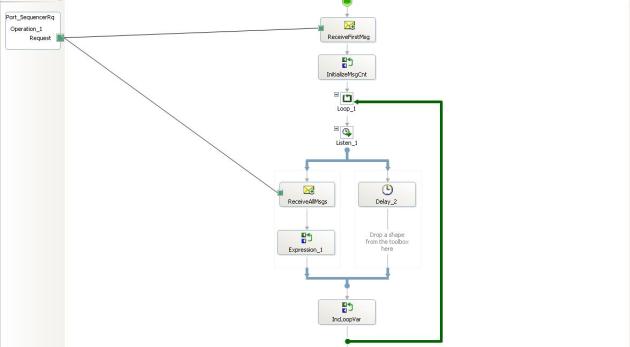Enterprise Integration Patterns Part-3 – Resequencer
October 20, 2009 3 Comments
At times ordered delivery of multiple messages are required and these messages are received in a non-sequential order. This problem is solved by the resequencer enterprise integration pattern. The resequencer integration pattern implies the following.
You can read more about resequencer pattern here.
In the example shown the incoming messages have a BatchID which works as a correlation set. The property is promoted to the message context and the correlation type is configured. The correlation is initialized by the first receive shape and the orchestration is started when the first message arrives. The message is saved in the SortedList of type System.Xml.XmlDocument so that we can save the message as a key value pair.
The sequence of the message is determined from the message payload and each message has the field for its sequence. To receive all the messages a listen shape with a receive which follows the correlation based on the batchID is placed and on the other branch a delay of 20 secs is configured. The loop terminates when all the messages in the message stream are received. Each message has a field of TotalMsgs which determines the total messages. A loop variable is incremented when each message arrives.

In the next loop all of the messages are returned to the send port in the right sequence.

Note:
Resequencing pattern must have a cache where the messages should be stored temporarily and when all the messages are received they must be sorted and sent in a sequence. However in this simple example we have used memory for storing messages whereas this approach is not good if the message size are very large. Another approach to store messages would be in a Database or on the Disk as a file. Storing on disk would involve efforts to retreive the files again. However storing in a database would also require connection to database, involving SQLServer/Oracle Ports and handling failure exceptions. I haven’t still found the best approach to cache messages, though I think storing the messages in the database would be best considering the performance factor.
You can download the sample here.



Hi Abdul,
Thanks for posting this solution. I’ve got it working just fine – just as long as all of the messages are received. In my test scenario where i only get three out of 4 messages, the delay never kicks in and the orchestration eventually dehydrates indefinitely (or at least longer than I care to wait). Upon 15000 milliseconds it is supposed to enter the delay branch and throw an exception.
Any ideas?
Please don’t waste time answering this. It was a foolish mistake on my part. Timespan(0,0,0,15000) thinking 15000 milliseconds. Needed one more argument – Timespan(0,0,0,0,15000).
I get this error when I use the addMsg with xmldocument and it try to dehydrate:
Im not sure how you can get past this problem?
Exception type: DehydrationFailedException
Additional error information:
Type ‘System.Xml.XmlDocument’ in Assembly ‘System.Xml, Version=4.0.0.0, Culture=neutral, PublicKeyToken=b77a5c561934e089’ is not marked as serializable.
Exception type: SerializationException
Source: mscorlib